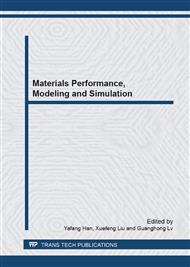p.407
p.414
p.421
p.425
p.432
p.437
p.444
p.450
p.456
Magnetic Properties for Magnetic Quantum Dot Arrays: Fast Fourier Transformation and Micromagnetism Study
Abstract:
Based on the Monte-Carlo simulation and fast Fourier transformation-micro-magnetism (FFTM) method, magnetic properties with different parameters for the 4×4 Magnetic Quantum Dot Arrays (QDA) were studied. The calculating processes show that the same calculated results can be obtained by both methods above. But the FFTM method can save much time in obtaining results, which suggest that the method be employed to study more complex systems. The calculated results indicate that there exists obvious difference in the magnetic hysteresis loops with different temperatures, which can be well explained by considering the relationship between the easy-magnetization axis and the organization anisotropy of the QDA system. Furthermore, saturation field (Hs) increases with the dipolar interaction increasing, which is attributed to the competition between dipolar energy (ED) and Zeeman energy (EZ). The calculated results can fit the experimental results very well. Besides, it is found that the dipolar interaction constant D has a great influence on magnetic properties.
Info:
Periodical:
Pages:
432-436
Citation:
Online since:
March 2013
Authors:
Price:
Сopyright:
© 2013 Trans Tech Publications Ltd. All Rights Reserved
Share:
Citation:


